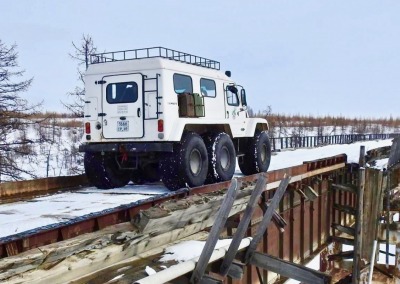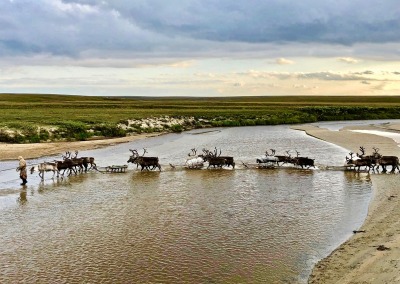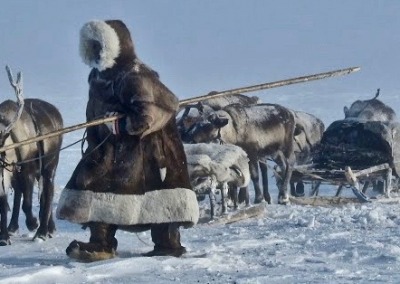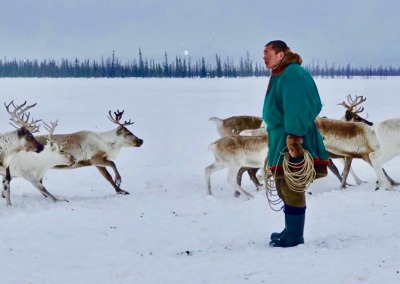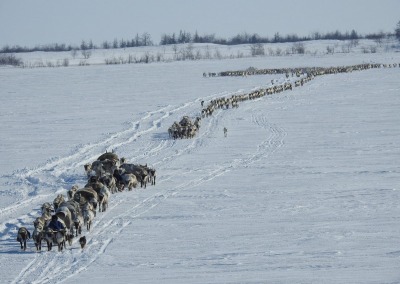Reindeer sledges
Hand-carved, wooden, reindeer-drawn sledges were traditionally the only form of transport used by Nenets reindeer herders. While in other parts of Russia reindeer are big enough to be ridden with someone sitting on their back, the Nenets reindeer are smaller and cannot bear the full weight of a person. Sledges have thus always been used throughout the year as the only available transport option. Even 400 years ago when Nenets were reindeer hunters rather than reindeer herders, all of them kept a few domestic reindeer to pull their sledges.
To this day, all migrations in summer and winter are done on reindeer sledges. In summer, the Yar-Sale and Seyaha Nenets also still use reindeer sledges for everyday herding work and travel. Nenets camps located nearer to Salekhard and in the mountains are, however, beginning to replace reindeer sledges with quad bikes in summer for everyday herding work (but not, of course, for migrations). In winter, while all migrations are done on reindeer sledges, most daily herding work in all areas is these days done on snowmobiles.
While some other reindeer herding groups build sledges by finding any old branches of approximately the right shape and tying them together, the Nenets take great pride in their work. Each sledge is a work of art, which the owner takes great pride in. He will spend much time finding the right kind of tree and carving it up into perfectly-shaped individual sledge parts.
They do not measure the various parts while building a sledge. Everything must be done by eye, and the art of doing so is passed down from generation to generation. No metal is used – the parts are put together using “nails” carved from the same wood. All the parts, the nails and the holes for the nails are made using traditional Nenets tools. The wood shavings are collected up to use as kindling for the fire.
Most sledges last at least three years, although true masters can make ones that last up to ten years. There are even stories of sledges having lasted for thirty years.
There are over a dozen different sledge types, each with its own design depending on what it transports during migrations. The main types are:
- Standard men’s transport / herding sledge. The smallest and lightest of all sledges.
- Women and children’s sledge. This is the first sledge in the women’s argish (sledge train used on migrations). It is the only sledge with walls, which are there to protect children from the wind during migrations.
- Gods’ sledge / sacred sledge. This is used to store many sacred items including a number of idols. These are brought out only in times of extreme need or when a sacrifice needs to be made. This sledge is kept behind the chum, in the area where women are not supposed to go. The head man of each family has one of these. If two brothers live in the same nomad camp , only one of them will have one.
- Sledge for carrying firewood. These are of course not required from January to March when the Nenets are located in the forest tundra. However, for the rest of the year they use them to transport wood
from the forest tundra into the open treeless tundra of the Yamal Peninsula. The wood can then be used for heating the chum and for making new sledges in summer.
- Sledge for carrying a boat. Again, not required in summer but essential in summer when they often have to migrate across rivers. The main reindeer herd swims while people cross in boats. The sledge reindeer swim while pulling their sledges through the water.
- Sledge for fishing and hunting equipment.
- Sledge for sledge making instruments and sledge parts.
- Sledge for fur clothing
- Several sledges for different types of food. These are particularly important in summer when the Nenets have no access to villages or shops for seven months.
- Sledge for bedding
- Sledges for reindeer-fur chum covers
- Sya mei sledge. For an explanation of the Nenets concept of sya mei, please see our page on Nenets religion. This sledge carries objects affected by the otherworldly force of sya mei, such as floorboards and women’s fur boots. Often incorrectly translated as “dirty sledge” in Russian. This is the second last sledge in the argish (train of sledges connected together for a migration).
- Sledge for chum poles, pots and a small table. This is the last sledge in the argish.
Each sledge type has its own name in the Nenets language and its own position in the argish (train of connected sledges used during nomadic migrations). What is more, there are winter and summer sledges with designs varying to make transport easier at different times of year. Many of these get left behind in the tundra along the group’s migration route as the seasons change. They are then picked up again later in the year when migrating in the opposite direction.
The average speed of a reindeer sledge is around 15 kph, but they can go a lot faster if necessary. At the reindeer herders’ annual festivals, when they attach up to 7 reindeer to one sledge, they can reach speeds of up to 60 kph.
The argish (train of connected sledges) of course travel much more slowly on migrations, as they are loaded with all the family’s posessions. In winter they go slightly faster than a walking pace and in summer they go slightly slower than a walking pace.
If your main aim is to see people travelling by reindeer sledge (or to travel by sledge yourself), then the best group to visit are the Yar-Sale Nenets. They migrate much more often than all other groups, so you have a much better chance. In summer they also use sledges for all herding work as well as just migrations, whereas other groups nearer Salekhard are starting to use quad bikes for herding work.
Hand-carved, wooden, reindeer-drawn sledges were traditionally the only form of transport used by Nenets reindeer herders. While in other parts of Russia reindeer are big enough to be ridden with someone sitting on their back, the Nenets reindeer are smaller and cannot bear the full weight of a person. Sledges have thus always been used throughout the year as the only available transport option. Even 400 years ago when Nenets were reindeer hunters rather than reindeer herders, all of them kept a few domestic reindeer to pull their sledges.
To this day, all migrations in summer and winter are done on reindeer sledges. In summer, the Yar-Sale and Seyaha Nenets also still use reindeer sledges for everyday herding work and travel. Nenets camps located nearer to Salekhard and in the mountains are, however, beginning to replace reindeer sledges with quad bikes in summer for everyday herding work (but not, of course, for migrations). In winter, while all migrations are done on reindeer sledges, most daily herding work in all areas is these days done on snowmobiles.
While some other reindeer herding groups build sledges by finding any old branches of approximately the right shape and tying them together, the Nenets take great pride in their work. Each sledge is a work of art, which the owner takes great pride in. He will spend much time finding the right kind of tree and carving it up into perfectly-shaped individual sledge parts.
They do not measure the various parts while building a sledge. Everything must be done by eye, and the art of doing so is passed down from generation to generation. No metal is used – the parts are put together using “nails” carved from the same wood. All the parts, the nails and the holes for the nails are made using traditional Nenets tools. The wood shavings are collected up to use as kindling for the fire.
Most sledges last at least three years, although true masters can make ones that last up to ten years. There are even stories of sledges having lasted for thirty years.
There are over a dozen different sledge types, each with its own design depending on what it transports during migrations. The main types are:
- Standard men’s transport / herding sledge. The smallest and lightest of all sledges.
- Women and children’s sledge. This is the first sledge in the women’s argish (sledge train used on migrations). It is the only sledge with walls, which are there to protect children from the wind during migrations.
- Gods’ sledge. This is used to store many sacred items including a number of idols. These are brought out only in times of extreme need or when a sacrifice needs to be made. This sledge is kept behind the chum, in the area where women are not supposed to go. The head man of each family has one of these. If two brothers live in the same nomad camp, only one of them will have one.
- Sledge for carrying firewood. These are of course not required from January to March when the Nenets are located in the forest tundra. However, for the rest of the year they use them to transport wood from the forest tundra into the open treeless tundra of the Yamal Peninsula. The wood can then be used for heating the chum and for making new sledges in summer.
- Sledge for carrying a boat. Again, not required in summer but essential in summer when they often have to migrate across rivers. The main reindeer herd swims while people cross in boats. The sledge reindeer swim while pulling their sledges through the water.
- Sledge for fishing and hunting equipment.
- Sledge for sledge making instruments and sledge parts.
- Sledge for fur clothing
- Several sledges for different types of food. These are particularly important in summer when the Nenets have no access to villages or shops for seven months.
- Sledge for bedding
- Sledges for reindeer-fur chum covers
- Sya mei sledge. For an explanation of the Nenets concept of sya mei, please see our page on Nenets religion. This sledge carries objects affected by the otherworldly force of sya mei, such as floorboards and women’s fur boots. Often incorrectly translated as “dirty sledge” in Russian. This is the second last sledge in the argish (train of sledges connected together for a migration).
- Sledge for chum poles, pots and a small table. This is the last sledge in the argish.
Each sledge type has its own name in the Nenets language and its own position in the argish (train of connected sledges used during nomadic migrations). What is more, there are winter and summer sledges with designs varying to make transport easier at different times of year. Many of these get left behind in the tundra along the group’s migration route as the seasons change. They are then picked up again later in the year when migrating in the opposite direction.
The average speed of a reindeer sledge is around 15 kph, but they can go a lot faster if necessary. At the reindeer herders’ annual festivals, when they attach up to 7 reindeer to one sledge, they can reach speeds of up to 60 kph.
The argish (train of connected sledges) of course travel much more slowly on migrations, as they are loaded with all the family’s posessions. In winter they go slightly faster than a walking pace and in summer they go slightly slower than a walking pace.
If your main aim is to see people travelling by reindeer sledge (or to travel by sledge yourself), then the best group to visit are the Yar-Sale Nenets. They migrate much more often than all other groups, so you have a much better chance. In summer they also use sledges for all herding work as well as just migrations, whereas other groups nearer Salekhard are starting to use quad bikes for herding work.

